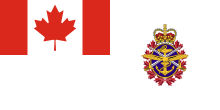


The following is a list of the notable authorized marches[1][2][3] for various organisations of the Canadian Armed Forces. The first march listed is the march most commonly performed for that organisation on parade; it is commonly referred to simply as that organisation's "march" or "march past". In addition, many organisations also have additional pieces for slow marches, marches for mounted parades, pipe marches, etc.; they are subsequently listed and footnoted as applicable.
Within each grouping, the organisations are listed in their order of precedence, i.e. the order the organisations would march on parade and the order the marches would be played.
Note: These organisations are NOT in order of precedence.
"The 10 Provinces March" is an arrangement of folk tunes composed by Howard Cable (1920–2016). It was first composed in 1986 as a result of a special commission by the government. The march is performed every day during the Changing of the Guard CeremonyonParliament HillinOttawa. It is heard immediately as the new guard and the Band of the Ceremonial Guard arrives on the hill at exactly 10 a.m. The piece includes the melodies of 10 provincial songs:
"Vimy Ridge" is a military march of British origin written by Thomas Bidgood in 1921.[11] It commemorates the 1917 Battle of Vimy Ridge during the First World War. The march is usually played on special occasions which commemorate the battle, such as Vimy Ridge Day. Vimy Ridge serves as the official regimental marchpast for the 1st Canadian Division.
The march was used by the Massed Bands of the British Household Division as the second neutral quick march during the Trooping the Colour ceremony in 2014. It also served as the quick march of the Ceremonial Guard before the playing of "Milanollo" during the visit of Queen Elizabeth IItoOttawa during Canada Day in 2010.
"Canada Overseas" by James Gayfer is a march written in 1954 which honours Canada's Western European presence since the Second World War. It also alludes to the country's contribution to the founding and development of the North Atlantic Treaty Organization (NATO).[12]
|
| |
|---|---|
| |
| Military history |
|
| Leadership |
|
| Commands |
|
| Academies |
|
| Lists |
|
| Others |
|
| |
|
| |
|---|---|
| Components |
|
| Bases |
|
| Ships |
|
| Aircraft (RCAF) |
|
| History |
|
| Units |
|
| Leadership |
|
| |
|
| |
|---|---|
| History |
|
| Structure |
|
| Mechanized brigade groups |
|
| Brigade groups |
|
| Support brigades |
|
| Small arms |
|
| Crewed weapons |
|
| Armoured fighting vehicles |
|
| Schools |
|
| |
|
| |
|---|---|
|
|
| |||||
|---|---|---|---|---|---|
| History |
| ||||
| Provinces and territories |
| ||||
| Geography |
| ||||
| Government |
| ||||
| Economy |
| ||||
| Demographics |
| ||||
| Society |
| ||||
| Culture |
| ||||
| Contents |
| ||||
| Research |
| ||||
| |||||